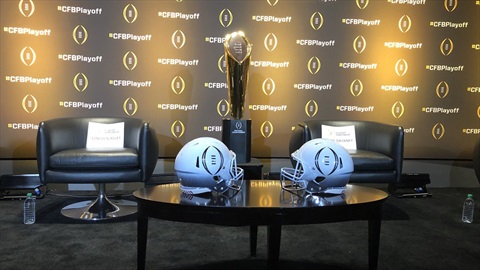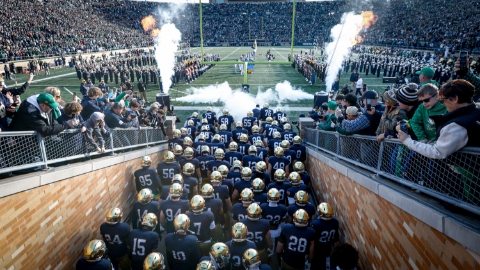As sports analytics explode, Notre Dame stakes its place in athletics

Each Notre Dame football practice concludes with a standing meeting: head coach Marcus Freemen and esteemed strength guru Matt Balis convene to pore over the myriad data points the Irish glean from the GPS systems and other technological advancements that measure everything from a player’s top speed to his total miles.
“Every day after practice I get with Coach Balis, and we look at the GPS systems and who’s in red, who has high-value numbers. I told the staff on Thursday, right now every number is above where it’s been. And so it’s great, it’s showing that their workload can increase but also that you can sustain if you continue to do it right. We haven’t had those small tissue strains. It’s a credit, to me, to being able to look at the analytics and look at their workload and also push them to get treatment. Hey, he’s in red, usually it’s be careful. Guess what? He hit the same workload the next day, and he’s fine.
Inside Frank Eck Baseball Stadium, Irish skipper Link Jarrett points to a device resting atop the press box that looks strikingly similar to a security camera.
Except it eventually feeds data to Jarrett & Co. outlining everything from velocity on balls being hit into play to the spin-rate and revolutions on every single pitch.
“That machine up there will spit every pitch that’s not hit, there’s probably 30 metrics,” Jarrett says, “and the ones that are hit, there’s probably 50. That’s how much comes, every pitch. It registers and gathers the angle the ball came off the bat, the speed, the spin of the ball.
“It’s a lot, but they don’t need to worry about all that. We try to filter through it and give him what they need out here.”
Now, Notre Dame is preparing for a convergence of two worlds: analytics on the playing fields and analytics in the classroom. The venerable, 180-year-old iconic academic institution is launching a sports analytics-centric masters in business analytics program, among the first of its kind across the nation. With a year-long term built with both general students and the time constraints of student-athletes at its forefront, the new program also is poised to bring together all comers in a burgeoning field.
“What we envision is with this being Notre Dame and the fact that a lot of students who are interested in sports analytics are not necessarily student-athletes, we envision this to be a great experience for them in class with student-athletes and a mix of students that will leverage our sports culture here in our programs,” says Notre Dame Professor Rob Easley, the John W. Berry Senior Department Chair. “MIT has been running an annual conference on sports analytics for a long time, and there are some real powerhouse people who can do some amazing things there, but no one thinks MIT when they think athletics. I think that’s a real synergy here.”
Easley, Corey Angst, Martin Barron and Brandon Erlacher are the de facto founding fathers of the Notre Dame program, now with approval from both the provost and dean for a summer launch.
“One of the motivations here, this is not just for student-athletes, and while it is geared toward fitting student-athlete schedules, anybody can take the program,” Angst says. “Being on the faculty board of athletics every year, we’re challenged with student-athletes that we would like to get into degree-seeking programs and not just taking random courses here and there. We have stronger requirements than what the NCAA does in that we require you to be enrolled in two undergraduate and one graduate level class, just for graduate students.
“We as the institution want them to continue their education in a way that rewards them with something at the end of it.”
Adds Erlacher, “There will be a lot of effort being placed into very targeted marketing efforts, inside and outside of the university as well as revamping the Web site to take advantage of what the program is going to be like but to also showcase projects worked on so that we can showcase the program and what’s going on. There will be some good marketing material, content marketing-wise and otherwise made available very shortly.”
While Notre Dame has had various offerings in its nationally renowned Mendoza College of Business, this new element not only is meant to bridge the sometimes-divergent paths of standard students with student-athletes but also to provide greater access for graduate-students from virtually all of Notre Dame’s 20 NCAA-sanctioned athletics programs.
It’s a component building in need since the onset two years ago of the COVID-19 pandemic and NCAA’s subsequent decision to grant additional years of eligibility to all student-athletes choosing to compete an additional season in their respective sports.
“We didn’t have great programs that fit into the schedules of student-athletes, not just football players, but we have fifth-year student-athletes in just about every program on campus,” says Angst, one of the school’s 15 members for its Faculty Board on Athletics that includes athletics director Jack Swarbrick and reports to school president, Rev. John Jenkins. “It impacts everyone. So the goal of this was to create a program that can work for student-athletes but also provides education that’s probably going to be really interesting with sports analytics.
“We know the goal going in is that about 90% of people in the program are not going to go pro, so we’re preparing them for a career in analytics. It’s a broad enough program that it doesn’t need to be sports analytics, but if they’re interested in it, there are growing opportunities. Every year we’re seeing more things grow in that sports analytics space. Performance analytics, stadium experience, ticketing. The bottom line is that we were looking to create something that continued to educate students in a way that’s rigorous and value-adding and saves time and serves their needs because they are an important constituent to us.”
So important, in fact, that group envisions an opportunity to collect numerous data streams from a wide array of Notre Dame’s athletics teams – not merely for the intrinsic value of the information but for the potential opportunity for their students to develop informational points that could assist their peers’ athletics endeavors.
“One thing often here in statistics, you need to have a subject matter expert, and oftentimes students have such good knowledge of sports, it gives them a chance to develop skills, with their background knowledge, and get a lot deeper with it,” says Barron.
“The GPS data from track every practice, games, sprints, motion technology, there’s a ton of it being produced, and there’s lots of progress using this technology. Having the background to fully analyze, combine that with cleaning the data (from its raw forms), working with human samples, through this the objective would be over time to develop pipelines for data for our teams. It can be used in things such as performance optimization, a big thing with sports data is injury prevention. Elements that by bringing in these systems, we can have students working on these and hopefully in a couple of years from now, we have a nice reporting pipeline built up, a dashboard for all our teams, and that hopefully leads to a reduction in injuries. That would be a pretty solid outcome.”
To that end, Notre Dame already is exploring the recent study, “Data-Driven Sports Ticket Pricing for Multiple Sales Channels with Heterogeneous Customers,” from Easley and the University of Colorado’s Ovunc Yilmaz in an effort to optimize the ticketing process – and revenue prospects – particularly as it pertains to major college football.
They looked not only at opponents and other variables such as date and time but also at specific seat locations within a venue.
After closely examining the ticket data of a major college football program, the study posits that “The optimal prices suggested by our data-driven pricing tool are based on a deep understanding of the customer decision-making process; therefore these prices are able to match the customers to seats in a more effective way,” Yilmaz told Notre Dame.
On the football field, the first-year coach Freeman, a charismatic, barnstorming sort who’s already populating the campus speaking circuit, points directly to the empowering asset of data as the coaching staff works to coax a career year from senior wideout Braden Lenzy.
“Braden Lenzy is the first person I think about,” Freeman says of practice data and its impact on the team this spring. “His workload has increased, and it’s just shown over the 10 practice, 11 practices, he just needs pushed. And he’s been great, his body can handle it.
“We study it every day, and every post-practice.”
Jarrett, firmly in any conversation dialing in on the nation’s top collegiate baseball coaches, blends his proactive approach to the game’s analytics with the baseball acumen he’s been honing since emerging from an All-American playing career at Florida State.
“The game, our game, is trying to figure out how the information needs to be properly used, and I think Major League Baseball with the launch of the ball and the velocity and the spin, the game is at a unique spot because it’s not the game baseball was once,” says Jarrett, his Irish the reigning Atlantic Coast Conference champions. “And I think people are trying to figure out if that style of baseball can win at the Major League level, and it all starts there. So what those guys do sometimes filters its way down. I don’t feel like that style of lift and pitch, I don’t think we’re built (at the collegiate level) for that. So the bunting and base running, those sort of things, that level of baseball may think it doesn’t equate.
“I think at this level it helps you. We have to be smart about the combination of using what we see at the highest level and keeping in mind what wins college games. That’s where the fork in the road is in this whole thing. What that spits out, sometimes, is part of the equation, but I don’t necessarily think it’s the complete answer all the time.”
The ultimate vision, Angst explains, is to equip Notre Dame’s students, athletes or otherwise, for ultimate professional success – while imbuing that path with a keen impact on the picturesque South Bend, Indiana, campus.
“Whether they’re graduating next year or just starting the journey,” Angst says, “I would love to see a big chunk working in athletics or athletic programs, but I’d also like to see internal successes here. We’d like to be able to point to here’s how in the classroom we studied this and determined they could strike out more batters and used that to improve their win-rate. Or, somewhat surprisingly, we’re finding there’s tons of data on rowing, so they can determine torque levels in the boats themselves. We would like to be able to point to the successes of that information.
“And, if I can get multiple of our graduates to go work for the Detroit Tigers in five years, because that’s my team, then that’s my hope.”
Notre Dame Fighting Irish Military Appreciation Full-Zip Jacket




